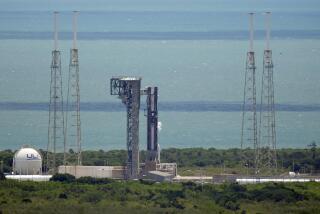Contact Is Restored With Magellan : Space: Signal caps a daylong effort by JPL scientists to regain control of Venus probe. Problems could delay scheduled mapping mission.
- Share via
Scientists at the Jet Propulsion Laboratory regained control of the spacecraft Magellan Friday evening, capping a daylong effort that began when controllers lost contact with it during a routine test Thursday evening.
After 14 hours of silence, the researchers had restored intermittent contact Friday morning with the sophisticated radar-mapping spacecraft, which entered orbit around Venus only a week ago.
The rest of the day was spent analyzing data from the spacecraft before the engineers finally sent a signal to the probe at 7 p.m., telling it to keep its antenna pointed at Earth.
By 7:35 p.m., Magellan had responded and JPL was once again in control. “We have established steady radio contact with it,” said JPL spokesman Allan Wood.
Friday’s unexpected troubles and efforts to prevent future glitches could set back Magellan’s mapping mission, originally scheduled to begin Aug. 29, by “days, weeks or even months,” said Steve Wallace, the spacecraft’s chief engineer.
The JPL engineers speculated that a glitch in the probe’s computer software caused the problem.
“I’m concerned, but this (loss of contact was) expected from time to time,” said Magellan chief scientist Steve Saunders. “I don’t like this, it makes me nervous. But we are doing something we haven’t done before . . . and it could happen many times.”
At the same time, however, scientists were buoyed by the receipt of preliminary pictures from Magellan “that look pretty damn good,” said project manager Tony Spear. He said the pictures, which cover an area of the mysterious planet 15 miles wide and 1,000 miles long, show old, hardened “lava flows and faults and fractures and (volcanic) cinder cones with craters on top.”
Those pictures will be released Monday.
JPL engineers lost contact with Magellan Thursday evening while they were testing the radar-imaging apparatus. During a routine orientation maneuver, the spacecraft turned its antennas from Earth and pointed a small on-board telescope at two bright stars whose positions provide reference marks for the spacecraft’s internal gyroscopes. “We didn’t get a signal back,” said JPL spokesman Alan Wood.
Engineers speculated that the craft may have been distracted by another star or even by sunlight reflected off the surface of Venus, disorienting Magellan’s internal reference system so that it could no longer point its antenna toward Earth.
The re-acquisition of Magellan’s signal Friday morning surprised engineers. Spear was in the midst of a news conference to outline ways of attempting to regain contact with the spacecraft when excited engineers ran in to announce a signal had been received from Magellan.
“It is Magellan’s signal . . . the spacecraft looks healthy,” said project engineer Steve Wall.
The signal indicated that the spacecraft was operating in a computer-induced state of hibernation called a “safe mode.” In this mode, the probe was supposed to rest and recharge for 18 hours, then initiate a process called “coning” to re-establish contact with Earth.
But Magellan apparently began coning about 10 hours sooner than it should have, puzzling the scientists.
In coning, the spacecraft is rotated slowly so its main antenna sweeps through a cone-shaped volume of space that should include Earth. While rotating, the craft automatically transmits information about what happened to it during the period when it lost contact.
Friday afternoon, the spacecraft was still coning and JPL engineers were receiving about 20 to 25 minutes worth of data every two hours. Spear said that after the team sent the transmission telling Magellan to leave its main antenna pointed in the direction of Earth, they ordered it to play back data recorded over the previous 36 hours so that they could determine precisely what went wrong.
The $551-million spacecraft uses radar to pierce the dense clouds that obscure the surface of Venus to conventional observation. It is expected to map the entire surface with a resolution 10 times better than has been available before, allowing it to identify objects as small as a football field.
Researchers hope to use such images of Venus’ surface to learn about the geological activity of this hot, dry planet which is, in size and proximity to the sun, virtually Earth’s twin. That information should, in turn, provide new insights into geological activity on Earth, where as much as three-quarters of the surface is hidden from researchers’ view by impenetrable oceans.
Loss of Magellan would have been a shattering blow to NASA, which has already been rocked this summer by the grounding of its shuttle fleet because of hydrogen leaks and a defect in the primary mirror of its highly touted Hubble Observatory.






